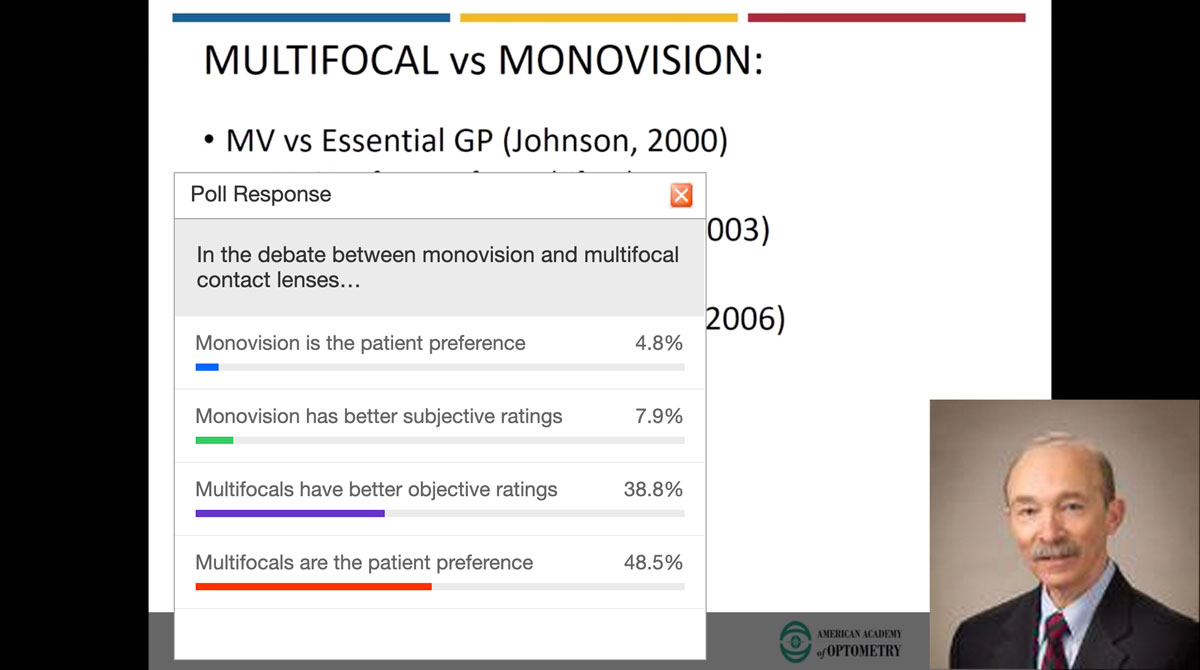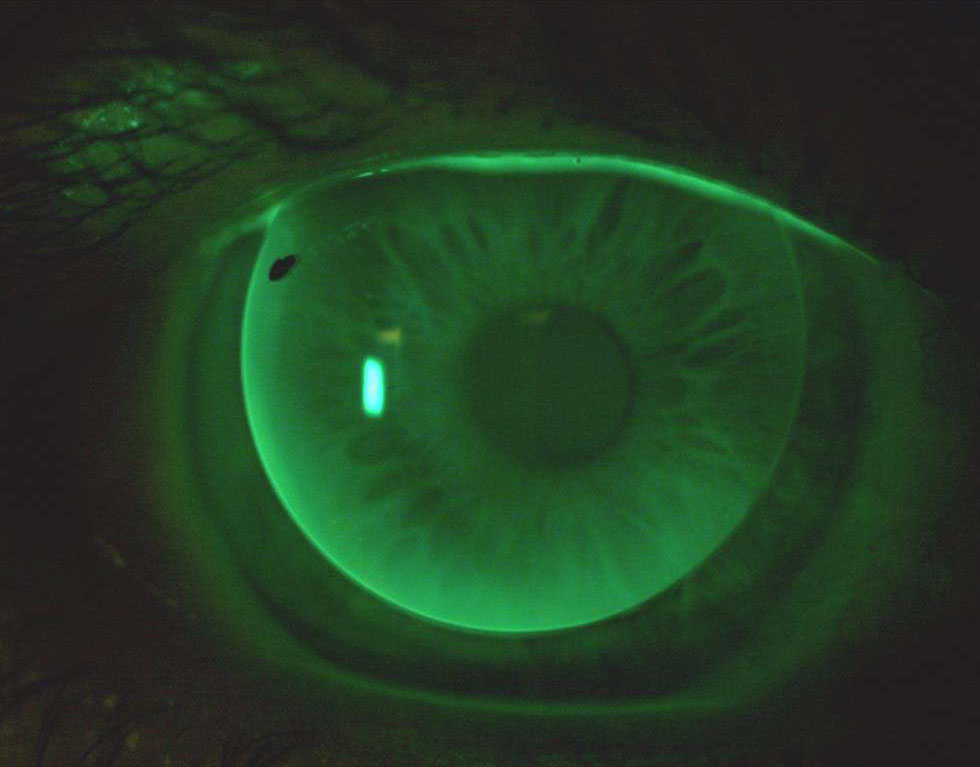Did you know that as many as 40% of your patients with presbyopia don’t know that bifocal and multifocal contact lenses even exist? Virtual conference-goers who tuned in to yesterday morning’s lecture, led by Douglas P. Benoit, OD, FAAO, do. They also know that new contact lens options are overcoming the negative stigma that used to define this form of correction.
Dr. Benoit met this topic head-on, encouraging his attendees to give multifocal contact lenses another try because it’s likely they will end up with a lot of happy patients.
Bifocal and multifocal contact lenses will always come with some limitations, and “anyone in practice for 15 years has had manufacturers telling them that their new lens is the best thing since sliced bread, and that simply wasn’t true,” Dr. Benoit admitted. “We were given high expectations and the lenses just didn’t live up to them.”
Clinicians have also found multifocal contact lenses to be time-consuming to fit, with just 39% of practitioners able to fit patients in one visit. Another 34% can do it in two visits, Dr. Benoit said, but some may take up to six visits. “This erodes patients’ confidence in our abilities, and it’s really frustrating for the practitioner,” he added.
Even after the fitting issues, up to 85% of presbyopic patients simply haven’t been satisfied with their vision in these lenses.
 |
| The interactive lecture included audience polls, which highlighted a high level of practitioner know-how, but also room for improvement. Click image to enlarge. |
Set Them Up for Success
So where does that leave the presbyope who is desperate to be free of glasses? According to Dr. Benoit, in multifocal contact lenses.
“If the patient has the right motivation, you set their expectations at the right level and they have a physiologically sound eye, they will do well in multifocal lenses,” he reassured his viewers. If they expect the perfect vision that they had at 25, they are going to be disappointed; “but some of the newer designs can come pretty close,” he added.
Who the patient is and what they do for a living has a significant impact on the lens design. The patient’s vocational and avocational needs are crucial, considering someone who works at a desk and needs good intermediate vision would do best in an aspheric design while an engineer with critical vision needs might be better served in a segmented design, according to Dr. Benoit.
The next step is maximizing the ocular surface so dry eye and meibomian gland dysfunction don’t interrupt comfortable wear.
But one the most important steps a clinician can take to be successful with multifocal contact lenses actually begins long before patients come in with presbyopia. You need to educate the patient in their 30s about presbyopia and the various corrective options, including multifocal contact lenses—before they even need them, he said. Glasses get tricky once a patient becomes presbyopic, and they will inevitably find themselves shuffling pairs around depending on the task at hand. “Putting on glasses adds a whole new dimension,” he explained. “Patients really don’t like this option, and they think it makes them look old.”
Today’s multifocal contact lenses, however, can provide the right patients with good distance and near vision—with the added bonus of intact depth perception. When patients were asked to compare monovision with multifocal contact lenses, most preferred the multifocals, according to Dr. Benoit. At least one study found more than three-quarters of patients preferred multifocals over monovision.
“Monovision has been around forever, and patients can be glasses-free with this option,” he said. “However, it comes with a huge trade-off, and that’s depth perception. In fact, the FAA won’t let pilots, whether commercial or recreational, fly in monovision. But they can fly with multifocals.”
Clinicians should be careful when assessing patient satisfaction with multifocal lenses, he cautioned. Monovision is actually great for the exam room atmosphere, and patients often do well with high- and low-contrast near vision tests. But in the real world? “Multifocal contact lenses perform better for just about everything, including night driving, watching TV and working on the computer,” Dr. Benoit said.
New and Improved Options
He then gave his audience a rundown of today’s lens materials and designs, including the many soft, gas permeable, hybrid and scleral lens options. Designs include center-near, center-distance, translating and even simultaneous image. If off-the-shelf lenses aren’t doing the trick, clinicians can turn to hybrid options and custom lens designs and make the lens specific to the patient.
One of the best additions to the market in recent years is daily disposable options, Dr. Benoit explained. “They are really great for many presbyopes, because they are good for part-time wear and patients don’t have to worry about cleaning them, just take them out and toss them,” he said. “Patients in daily disposable lenses are 12 times less likely to have dry eye, and if you can keep the lenses clean and wet—which you can do with daily disposables—you can keep patients happy.”
 |
| With an ideal aspheric GP fit, the lens tucks under the top lid and the lens is pulled up by the lid when the patient looks down to read, according to Dr. Benoit. Click image to enlarge. |
Among the myriad lens designs Dr. Benoit discussed, his favorite was bi-aspheric gas permeable lenses. The simultaneous image design has the advantage of providing an intermediate power, so patients can see at intermediate distances, “which, remember, is ideal for patients who work in front of a computer,” he noted. “These really were my go-to lens.”
Another good option that practitioners shouldn’t overlook are hybrids. These can give patients the clear vision they want, with the comfort of a soft lens. These lenses are excellent options for patients with moderate amounts of astigmatism, Dr. Benoit added.
One of the best things about the field of contact lenses is that innovations are in the pipeline all the time, and Dr. Benoit piqued his audience’s attention with a glimpse at the new lenses coming to market in the future, including those with wavefront-guided and combination designs. New technology such as topographers and OCT are game changers for providing precise measure that improve the lens fitting experience, he added.
He wrapped up the session with a few overarching pearls of advice, the most important being that presbyopia, no matter how you manage it, will always be a compromise—maybe.
“This is becoming less of an issue with the enhanced designs and improved practitioner skills,” he suggested. “The bottom line is, there’s an 80% chance you will have a successful fit, especially with all of the new designs out there to choose from.”
